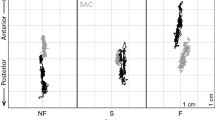Abstract
We investigated changes in saccadic reaction time in relation to the degree of increase in activity of neck extensor muscles when neck flexion occurred, and assessed the reliability of the measurements. Saccadic reaction time was measured firstly, during neck flexion angles set at 5° increments from 0° (resting position) to 25°, with the chin either resting on a stand or not, and secondly, during shoulder girdle elevator muscles providing a relative muscle force of 30%, with the neck flexion angle maintained at 0° by having the subjects rest their chins on a stand. Saccadic reaction time was evaluated by the latency to the beginning of eye movement toward the lateral target, which was moved at random intervals in 20° amplitude jumps. Muscle activity in the trapezius muscle was evaluated using the mean amplitude of electromyogram recordings. Very high coefficients of reliability in muscle activity and saccadic reaction time were observed between the two sets of tests at 1-h intervals and also among the three trials with a 1-min rest. When their necks were flexed and the subjects rested their chins on a stand, muscle activity increased slightly in accordance with the enlargement of this angle, with no significant change in saccadic reaction time. With the chin not resting on the stand, muscle activity increased gradually, while the saccadic reaction time decreased to that obtained at an average neck flexion angle of 20°. However, the angle where the shortest reaction time was obtained showed considerable individual variation (5–25°). Activity in the trapezius muscle at a 20° neck flexion angle, with the chin not resting on the stand, was far less than that for 30% maximal voluntary contraction in shoulder girdle elevator muscles. Nevertheless, the saccadic reaction times were roughly equivalent under the two different sets of conditions. No sex differences were observed in terms of saccadic reaction time under any set of conditions.
Similar content being viewed by others
Author information
Authors and Affiliations
Additional information
Accepted: 27 September 1999
Rights and permissions
About this article
Cite this article
Fujiwara, K., Kunita, K. & Toyama, H. Changes in saccadic reaction time while maintaining neck flexion in men and women. Eur J Appl Physiol 81, 317–324 (2000). https://doi.org/10.1007/s004210050049
Issue Date:
DOI: https://doi.org/10.1007/s004210050049




